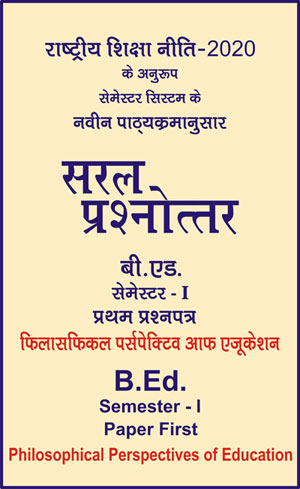|
बी एड - एम एड >> बी.एड. सेमेस्टर-1 प्रश्नपत्र-I - फिलासफिकल पर्सपेक्टिव आफ एजुकेशन बी.एड. सेमेस्टर-1 प्रश्नपत्र-I - फिलासफिकल पर्सपेक्टिव आफ एजुकेशनसरल प्रश्नोत्तर समूह
|
5 पाठक हैं |
|||||||
बी.एड. सेमेस्टर-1 प्रश्नपत्र-I - फिलासफिकल पर्सपेक्टिव आफ एजुकेशन (अंग्रेजी भाषा में)
Question- Discuss the characteristics of Buddhist Education.
Answer -
Characteristics of Buddhist Education
Buddhist education was considered the best means of education in its time. Buddhist education system had all the traits of an international education system. Foreign students used to study in Buddhist Education institutions like – Nalanda, Taxila etc. Even foreign professors or educators used to come and impart knowledge at Buddhist institutions. Buddhist education system consists of Maths and Vihars whose administration was done by Buddhists alone and that too in favour of themselves. But what made Buddhist education so famous which can be fairly understood by naming a few characteristics of Buddhist education. These are given below –
(1) Economical System – Administrative expenses of ‘Vihar’ and ‘Math’ etc. were borne by their founders or disciples and alms donated by the people.
(2) School’s Building – In Buddhist education infrastructure, school’s buildings were fairly large.
(3) Students’ population – A fair number of students used to study there, but teacher-student ratio was 1:10 or 1:15.
(4) Pradey – Entrance to such institution was quite difficult. Attaining a certain age, students were enrolled in such institutions via a ritual called Pavajja conducted with the help of Pradey. Students on attaining 20 years, again had to pass the entrance exam for higher education. For primary education students’ age limit was 8 years.
(5) Relationship between teachers and students – Under this education system, equation between teacher and students was very fair and was based on the concept of love and mutual understanding. Both students and teachers used to take care of themselves, thus cultivating the habit of co-existence and principles of management among them.
(6) Teacher’s eligibility and Remuneration – Under the Buddhist education system, a monk can become a teacher only when he has completed 10 years as a monk. Again, good behaviour, pious life, and thinking were the eligibility criteria for becoming a teacher. Earlier there were no provisions for remunerating teachers. Two end’s meet was considered payment of teachers.
(7) Rules and Regulation of students life – These were given below –
(i) Procure alms
(ii) Eat simple food
(iii) Wear simple clothing (Tisivra)
(iv) Take bath at set intervals
(v) Water games were forbidden
Discipline among students was maintained at all costs. At the time of admission, students strictly followed 10 rules which are enumerated below –
(i) Do not kill animals
(ii) Do not steal
(iii) Stay away from illogical practices
(iv) Not to consume food at unearthly hours
(v) Not to lie
(vi) Not to consume drugs
(vii) Not to sleep at high level beds
(viii) Do not take silver and gold as alms
(ix) Stay away from dance, music, and plays
(x) Stay away from make-up etc.
|
|||||














